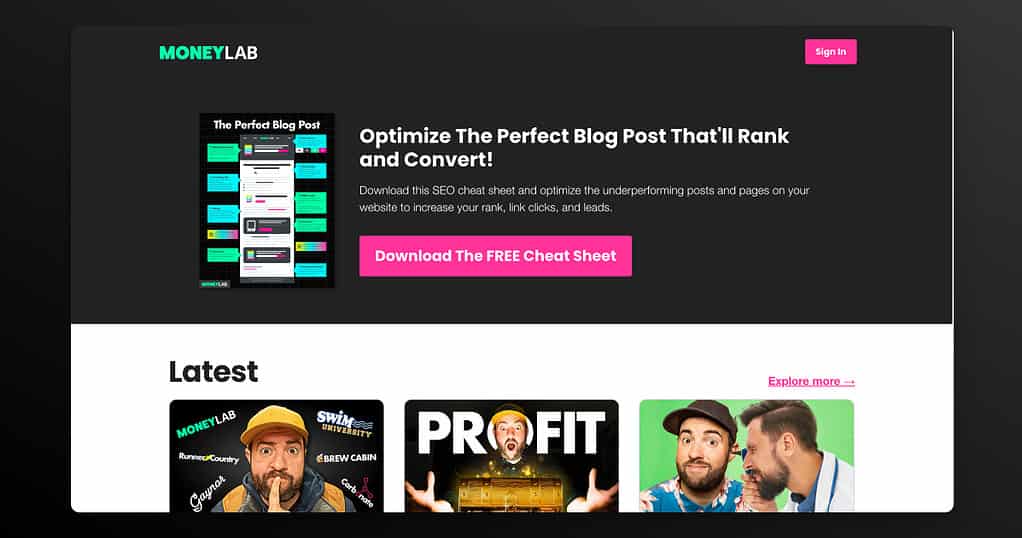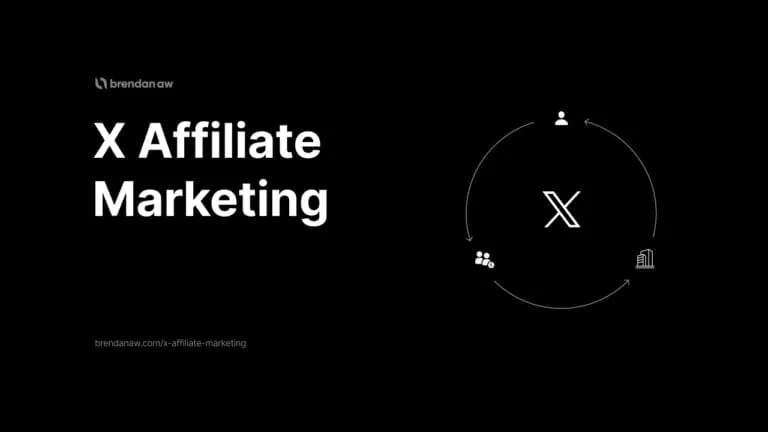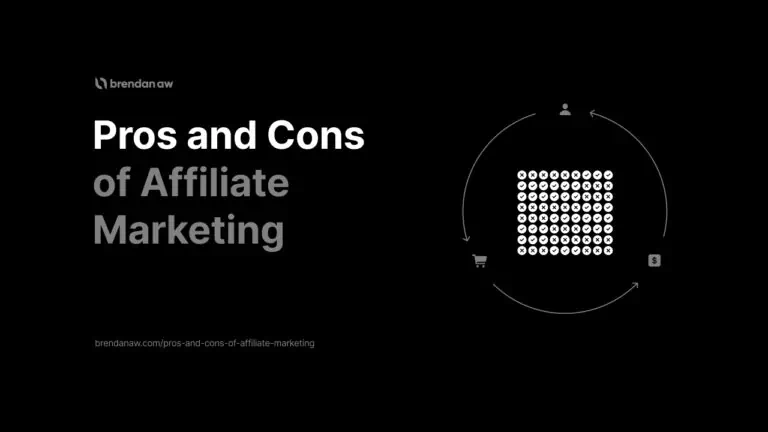Every successful affiliate has one thing in common…
A high-converting funnel for the products they promote.
Those just starting affiliate marketing rarely do this…
That’s why they can’t get sales.
I’ll give you a step-by-step guide on how to build an affiliate marketing funnel to suck readers down a rabbit hole and get those fat commissions.
Let’s get started.
What Is an Affiliate Marketing Funnel?
An affiliate marketing funnel is designed to increase conversion rates through tailored affiliate marketing content at different stages of the buyer’s journey.
This funnel typically maps out sales of affiliate products from the point of discovery to purchase.
It typically follows the same structure as a sales funnel, which has five stages:
- Awareness
- Interest
- Consideration
- Conversion
- Loyalty
Failing to add value to each will make it harder for you to convert.
You might think affiliate marketing is a pyramid scheme because you’re recruiting people into your ecosystem and getting them to act as advocates…
But that is far from the truth.
It’s a legitimate lead nurturing tactic used by ALL businesses.
How Does a Sales Funnel for Affiliate Marketing Work?
A sales funnel for affiliate marketing is often a sequence of marketing actions targeted at a product’s sales through building interest in a product/service based on the customers’ current position in the buyer’s journey.
What is a buyer’s journey?
It explains potential customers’ multi-step process before buying a product/service.
Most humans psychologically show either of these two customer journey patterns:
- AIDA model
- PS-AIDA-P model
AIDA stands for Awareness, Interest, Decision/Consideration, Action/Conversion.
Prospects enter the funnel when customers become aware of your products/services.
Next, you build interest in your products/services by introducing the affiliate product and benefits of the affiliate.
The previous sequence is followed by a decision to choose or not choose your products/services.
If the customer chooses to purchase your products or services, then the action sequence has been initiated and completed.
The PS-AIDA-P model is something I came up with.
It’s the AIDA model with two more acronyms in the front and back.
- PS: Potential customer first becomes aware of their Problems and the need for a Solution.
- P: Post-purchase experience and the likelihood of repeated purchases.
Why Do You Need an Affiliate Marketing Sales Funnel?
If you want to make sales with the least amount of friction…
You need an effective affiliate marketing sales funnel.
Readers must be served the appropriate content according to their awareness levels.
Let’s dive deeper into why you need one.
1. To Put Together a Strong Affiliate Offer
You can better coordinate your marketing efforts and put together an irresistible offer.
Because you’re forced to think about how to build interest and sales.
This generally comes down to copywriting.
2. To Measure Performance
Funnels help you measure the effectiveness of your messaging at each stage and identify opportunities for improvement through metrics like:
- Conversion rates
- Open rates
- Click-through rates
- Customer lifetime value
- Bounce rate
- Traffic sources
It’s difficult to decipher what’s working if you don’t track.
3. Increase Your Conversion Rates
You can increase the conversion rate by nurturing leads till they are ready for purchase.
Nurturing leads helps you connect with your audience and create a stimulus that develops over time.
Why?
Because they are often at different stages of the buyer’s journey with different intents.
Some are looking for information. Some may want further research. Some may already want to buy.
Your conversion rates will drop if you serve the wrong message with the wrong intent.
4. Gain Trust
Each stage of the funnel is an opportunity to demonstrate experience, expertise, and authority.
These three ultimately lead to trust.
And they are vital to any sales decision.
Customers will buy only if you know your sh!t.
5. Build a Prospect List
Rather than simply adding affiliate links and getting one-off sales. Build your email list.
Collect emails at each stage to sell your own or more products in the future.
6. Offer Value Potential Customers Cannot Resist
You get an insane opportunity to offer value other forms of direct sale will not afford you.
Through a lead magnet, a free webinar, or a course, you can present yourself as an expert and influence the sales decision of potential customers.
Done right. It will make the customer more attuned to the affiliate product you promote.
7. More Referral Commissions
Why do all the work yourself?
Encourage those that buy from you to promote your affiliate links too.
Send personalized messaging at the referral stage.
Or even get them to sign up as sub-affiliates.
How To Create a Funnel for Affiliate Marketing?
Now let’s get those juicy affiliate commissions.
Here is my 5-step process to create an affiliate marketing funnel.
- Put Together a Good Offer
- Create Your Bridge Page
- Setup Email Automation
- Set Up a Landing and Thank You Page
- Pick a Traffic Source
1. Put Together a Good Offer
The offer is the last touch point before a customer makes a purchase. So you need to get this right.
Tips for putting together a good offer include:
- Promote a product you like using. This goes without saying, and it’s much easier to write compelling copy when you actually know its benefits.
- It should be useful to your target audience. I don’t think I need to tell you not to promote a product your audience doesn’t need, right?
- Does it have an affiliate program? That’s the whole point of this. Ensure that it’s worth your time.
- Does the company have affiliate assets? Most affiliate programs will have an asset tab with their promotional material.
- Sign up for other affiliate newsletters. The best way is to observe how others are putting their offers together.
2. Create Your Bridge Page
Most affiliate products already have a sales page.
It’s not always necessary, but a fail-safe against bad copy on their sales pages.
Primarily, the bridge page builds buyers’ interest in the product you’re promoting.
Other perks include building credibility with your audience by showcasing:
- A hands-on video review
- Other customer testimonials
- An incentive
- Personalized message
There are three types of bridge pages worth considering
A Typical Bridge Funnel
The typical bridge funnel is straightforward.
Your paid ads lead to a copy, video, or personalized message that stimulates your buyer’s interest in the product.
Afterward, you can lead them to the sales page to make a purchase.
A Squeeze Page Bridge Funnel
A squeeze page uses lead generation as its core strategy.
You will be required to give out a freebie to incentivize signups.
The CTA of your promotion should lead them to your squeeze page.
And the copy should highlight the benefits of the free resource.
Set up email automation to collect the emails of those who want your free resource and email them the sales page a few days after.
Or use a warm-up sequence to nurture leads through the point of sales.
Afterward, you can email them the affiliate product’s sales page.
A Squeeze Page Bridge Funnel
The affiliate quiz for multiple bridge funnels works differently.
You should promote different products in the same affiliate niche or types of the same product.
Traffic from paid ads leads you to a landing page with a quiz.
The quiz aims to collect data on specific customer needs and serve them appropriate content.
Based on the results, they will be redirected to a bridge page for that specific product.
If necessary, a warm-up sequence may precede an email that directs leads to the sales page.
3. Setup Email Automation
This whole funnel wouldn’t work with email automation.
An email series will guide subscribers from the Awareness to the Consideration stage and hopefully a purchase.
Do this once, and the rest is on autopilot.
Start by choosing an autoresponder for affiliate marketing and create your opt-in forms.
Then it’s time to set up the email sequence.
If I was trying to promote an AI SEO software tool like NeuronWriter that specializes in On-Page SEO content optimization.
The series would look like something like this.
- Top 10 On-page SEO best practices
- How to optimize a blog post for on-page SEO
- Best way to use On-Page SEO software
- A short review of NeuronWriter
- Case study of an article ranking on page one of Google with NeuronWriter
- Urgency and FOMO
At this point, your leads are pretty warm. They are primed to be sent to the bridging page.
Alternatively, you can insert upsells or downsells as well.
4. Set Up a Landing and Thank You Page
You’ll need a landing and a thank you page for your lead magnet.
Suppose you have a hosted website on WordPress, like me. You can create landing pages via any affiliate website builder.
I’m using Kadence with WordPress…
And you can embed the form directly on the page using code snippets.
Alternatively, email marketing tools like ConvertKit allow you to create one even without a website.
Here are some tips for a highly converting landing page.
- Start with a powerful headline. If you’re giving out a lead magnet (ebook, free course, webinar), your headline should clearly state the expected outcome.
- Benefits, benefits, benefits. Not features. Just benefits.
- Include frequently asked questions. The landing page copy isn’t meant to be as comprehensive as a blog post. So include an FAQ section to answer common objections.
- Include social proof. These can include testimonials, third-party reviews, emails or even social media messages. You can use Senja to display beautiful-looking testimonial widgets on any page.
Most email software automatically displays a thank message or redirects subscribers to a page after completing the form.
But I prefer making my own so that I can:
- Customize my branding
- Remind signups to check their spam folder and confirm their subscription
- Add more personalize copy
5. Pick a Traffic Source
Now that you have set up a high-converting affiliate marketing funnel, it’s time to consider ways to drive traffic to your bridge page and merchants.
Short term traffic
Short-term traffic includes Facebook, Google, Instagram, Youtube, Twitter, and LinkedIn ads.
All these paid ads are considered short-term traffic because they last for only the promotion period.
Tips for your paid ad promotions include:
- Use CTAs that drive traffic to your bridge page. This is very important for all your social media promotions.
- Choose the right social platform. Find out where your ideal customers are hanging out. If you’re trying to target business professionals. LinkedIn might be the one. Not TikTok…
Ads help you reach people outside your network. But momentum drops once you stop.
You can spread risk and simultaneously reach new people who could become followers.
Long-term traffic
SEO is my favorite free traffic source for affiliate marketing.
The average SEO campaign generates 1000% more traffic than social media campaigns.
An effective SEO strategy encompasses on-page, off-page, and technical SEO.
Here are a few tips:
- Write more content around low to medium-competition, high-volume search queries
- Focus on informational or commercial search intent (how to set up your dishwasher), comparison (the best dishwashers in 2023), and product keywords (Samsung dishwasher review).
- Get backlinks and enough internal linking of your web content.
- A social media page with a large following and engagement boosts you.
- Leverage guest posting
The above highlights On-page and Off-page SEO.
They are content-driven compared to Technical SEO, which can be…
…well, very technical.
You might have to tinker with a little code.
Hire an expert if you don’t know what you’re doing.
Best Affiliate Marketing Funnel Examples
Let’s take a look at three examples of marketing funnels from affiliate marketers getting your dream result.
B the Installer
First, we have B the installer. He’s an affiliate marketer promoting TVs.
- He uses the multi-bridge gap through a quiz on his landing page that helps you assess your TV needs.
- He then suggests the best TV for you from his list of affiliate products.
- From the selection, he recommends one product that will suit your needs.
- After your quiz, you’re asked to provide your email for a more detailed report and content to help you find the perfect TV.
- B the Installer promotes affiliates and uses his YouTube channel to provide valuable content.
MoneyLab
Next, we have Matt Giovanisci of MoneyLab.
- His landing page starts with a powerful headline and a clear CTA early enough.
- This is followed by a list of his latest and best blog posts/marketing videos.
- Matt links to his social profiles from his website.
- Also, his About section succinctly talks about himself and lists some of his favorite tools.
- He inserts a link to purchase some of them and a link for a free trial.
Miles Beckler
To wrap this up, we will take a look at Miles Beckler.
- Again, his landing page starts with a powerful headline and a CTA early enough on the page.
- He’s giving out a free ebook in exchange for emails.
- He also puts out a lot of social proof through testimonials and emails from people who have bought his digital products.
- He links his site to all his social profiles and provides valuable content through a list of his most popular and latest blog posts.
Mike, Matt, and B, the Installer, have a clear strategy.
They create a community by offering valuable information to a ready market and then make sales by promoting affiliate products through recommendations.
Affiliate Marketing Funnel Template
The typical affiliate marketing funnel follows the progression below.
- Generate Traffic using paid ads or organic search traffic with SEO.
- Affiliate offers, e.g., lead magnets, ebooks, freebies, etc.
- Nurture leads through a sequence of emails offering more value.
- A sales/bridge page where you pitch sales.
- The product page of the merchant
There are many different ways to create one.
It’s important to understand that there are no hard rules. But an effective affiliate marketing funnel includes a combination of the above.
Feel free to make slight alterations based on what works in your niche.
Affiliate Marketing Funnel (FAQs)
How Can I Seamlessly Design My Affiliate Funnel?
You can use a free funnel builder like involveme if you don’t want the hassle of creating it using your own website page builder.
There are several free funnel builders popular among affiliate marketers who do not have a website. Look up free funnel builders online to choose what works for you.
Some premium builders like ClickFunnels have way more features. But they only provide free trials and not free plans.
Can You Use ClickFunnels for Affiliate Marketing?
Yes. You can use ClickFunnels for affiliate marketing, but it’s paid software.
How Can I Improve My Results as an Affiliate Marketer?
You’ll need to master traffic generation with paid ads or SEO and proper copywriting frameworks to craft compelling text to convert visitors to buyers through an effective affiliate sales funnel.
What Is the Difference Between the Affiliate Marketing Funnel and the Marketing Funnel of the Product?
The first has a customized affiliate link where they get rewarded for one-off and repeat sales.
The latter only rewards people for one-off sales.
Also, an affiliate marketing funnel is customized for the marketer’s brand all through the funnel. Until sales, there is no connection to the product page.
To Sum Up
Every stage of the funnel should, directly and indirectly, influence buyer decisions.
But be careful not to appear aggressive…
Focus on highlighting the benefits and what is in it for them at every stage.
You have all you need to double your affiliate marketing ROI.
Good luck with it!













